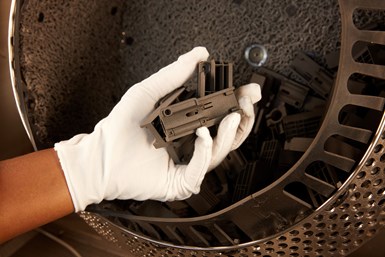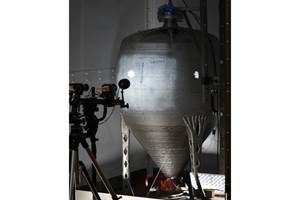Formlabs Augments Fuse Ecosystem With Fuse Blast, Automated SLS Postprocessing
Formnext 2023: Media blasting, once a recommended step, is now a needed requirement and the Fuse Blast eliminates struggles experienced in manual postprocessing efforts.
Formnext 2023: Media blasting, once a recommended step, is now a needed requirement and the Fuse Blast eliminates struggles experienced in manual postprocessing efforts.
Formlabs is augmenting its Fuse ecosystem with the addition of Fuse Blast technology for media blasting and the enhancement of its selective laser sintering (SLS) software to reinvent and automate SLS postprocessing. Fuse Blast is a fully automated cleaning and polishing solution that reinvents postprocessing for SLS parts. The company has also enhanced its SLS software to enable the ability to print better, faster parts on Formlabs Fuse Series printers.
By expanding the Fuse Ecosystem, the company aims to take SLS printing to the next level both quicker and easier. With the launch of the Fuse Blast, Formlabs is reinventing SLS postprocessing to now be fully automated. Fuse Blast is an advanced, automated postprocessing solution for SLS parts that quickly removes powder and consistently delivers professional parts that are clean to the touch in as little as 15 minutes.
To accompany Fuse Blast, Formlabs is expanding its SLS software for Formlabs Fuse Series Printers to enable faster job setup, printing and post processing efforts. Updates include an improved packing algorithm for over 15% packing density, print file generation and upload time both decreased by 50%, and reduced vacuum time in between prints. The improvements also include 15% less wait time in the preprinting phase and a 30% increase in printing speed for Nylon 12.
Formlabs will also offer an optional polishing system available next year. Fully automated part postprocessing enables users to save on overhead costs with passive filtering and reduces overall labor time for postprocessing parts by 80%.
The Fuse Blast is compatible with all SLS materials. It features automatic tumbling, which can be the best option to effortlessly clean printed parts. This feature provides a completely hands-off approach while supporting multimaterial tumbling. A combination of basket rotation, compressed air and abrasive media quickly removes semi-sintered and loose powder, giving users cleaned parts in just 10-15 minutes.
It features an in-line ionizer neutralizes charged parts by releasing surface dust and media residue, ensuring powder-free and clean-to-the-touch parts every time. It prevents dust from resettling on the parts and reduces overall powder contamination in the workshop.
Fuse Blast’s preprogrammed routines have three available settings to deliver optimized results and eliminate guesswork. The standard setting can be used for most parts; Nylon 12GF Powder is for when it’s necessary to get rid of strong surface armor; and delicate setting is for parts that require a more gentle tumble cycle.
The system offers manual assisted and handheld cleaning options. For larger parts, the manual assisted cleaning option enables users to hold parts with both hands to easily clean parts manually in a bright workspace. For precision cleaning efforts, the flexible manual handheld cleaning option enables users to easily clean more intricate parts by precisely directing the gun into all angles of the part.
It offers passive media separation as the filter separates out powder and debris from clean media to reduce waste and enhance performance. This process extends media life by reducing media saturation and enables faster processing on Fuse Sift.
A Fuse Blast polishing system will be available globally in Q2 2024. This optional upgrade will enable users to go beyond cleaning to surface finishing, delivering parts that are not only clean but also smooth, scuff-resistant and dye-ready with a professional semigloss finish.
“Media blasting has long been considered a pain point for customers and the introduction of the Fuse Blast will enable users to save both time and money with the same ease of use Formlabs is known for,” says Dávid Lakatos, Formlabs chief product officer. “Adding Fuse Blast to our ecosystem will advance SLS 3D printing, enabling users to push boundaries to complete projects more precisely and quickly than ever.”
- Read about Formlabs’ elastomeric resins which expand options for patient-specific care. Formlabs’ first elastomeric BioMed materials — BioMed Elastic 50A Resin, BioMed Flex 80A Resin and IBT Flex Resin — can streamline workflows and reduce labor time for flexible, dental and medical biocompatible parts.
- Learn about the Formlabs part removal mechanism that enables lights-out production. It is a build platform that overcomes the need for manual part removal, thereby enabling automated part handling and therefore continuous production from one build cycle to the next.
Related Content
Finland’s Largest Metal 3D Print Withstands Pressure Vessel Test, Vastly Exceeding Expectations
The pressure vessel was created in cooperation between Andritz Savonlinna Works and the Finish Additive Manufacturing Ecosystem (FAME), and withstood the nondestructive and destructive tests carried out by LUT University.
Read MoreAssonic Develops Automated System for Processing Reactive Metal Powders Without Gas Loss
Formnext 2024: The Assonic SPC 500 system features a closed circuit for conveying both powder and gas to eliminate gas loss while processing reactive metal powders in additive manufacturing.
Read MoreTrinkle Additive App Suite Features Collection of Accessible, Intuitive Design Apps
Formnext 2024: The Additive App Suite builds on the success of the company’s fixturemate — a user-friendly design app for creating fixtures. The software includes three new apps with more to come.
Read MoreEvonik Develops Develops Carbon Black 3D-Printable Powders for PA12 Polymer Applications
Formnext 2024: PA12-based Infinam 6013 P and Infinam 6014 P are specially designed for laser powder bed fusion techniques like selective laser sintering, and offer high flowability and homogenous sintering.
Read MoreRead Next
Bike Manufacturer Uses Additive Manufacturing to Create Lighter, More Complex, Customized Parts
Titanium bike frame manufacturer Hanglun Technology mixes precision casting with 3D printing to create bikes that offer increased speed and reduced turbulence during long-distance rides, offering a smoother, faster and more efficient cycling experience.
Read More3D Printed Polymer EOAT Increases Safety of Cobots
Contract manufacturer Anubis 3D applies polymer 3D printing processes to manufacture cobot tooling that is lightweight, smooth and safer for human interaction.
Read MoreProfilometry-Based Indentation Plastometry (PIP) as an Alternative to Standard Tensile Testing
UK-based Plastometrex offers a benchtop testing device utilizing PIP to quickly and easily analyze the yield strength, tensile strength and uniform elongation of samples and even printed parts. The solution is particularly useful for additive manufacturing.
Read More





















